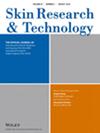A comparison of several separation processes for eggshell membrane powder as a natural biomaterial for skin regeneration
IF 2
4区 医学
Q3 DERMATOLOGY
引用次数: 0
Abstract
BackgroundNumerous studies have focused on skin damage, the most prevalent physical injury, aiming to improve wound healing. The exploration of biomaterials, specifically eggshell membranes (ESMs), is undertaken to accelerate the recovery of skin injuries. The membrane must be separated from the shell to make this biomaterial usable. Hence, this investigation aimed to identify more about the methods for membrane isolation and determine the most efficient one for usage as a biomaterial.Methods and materialsFor this purpose, ESM was removed from eggs using different protocols (with sodium carbonate, acetic acid, HCl, calcium carbonate, and using forceps for separation). Consequently, we have examined the membranes' mechanical and morphological qualities.ResultsAccording to the analysis of microscopic surface morphology, the membranes have appropriate porosity. MTT assay also revealed that the membranes have no cytotoxic effect on 3T3 cells. The results indicated that the ESM had acquired acceptable coagulation and was compatible with blood. Based on the obtained results, Provacol 4 (0.5‐mol HCl and neutralized with 0.1‐mol NaOH) was better than other methods of extraction and eggshell separation because it was more cell‐compatible and more compatible with blood.ConclusionThis study demonstrates that ESMs can be used as a suitable biomaterial in medical applications.蛋壳膜粉作为皮肤再生天然生物材料的几种分离工艺比较
背景大量研究都集中在皮肤损伤这一最常见的物理损伤上,目的是改善伤口愈合。对生物材料,特别是蛋壳膜(ESM)的探索,旨在加速皮肤损伤的恢复。蛋壳膜必须与蛋壳分离,才能使用这种生物材料。为此,我们使用不同的方法(碳酸钠、醋酸、盐酸、碳酸钙和使用镊子分离)将蛋壳膜从鸡蛋中分离出来。结果根据显微镜下的表面形态分析,膜具有适当的孔隙率。MTT 试验也表明,膜对 3T3 细胞无细胞毒性作用。结果表明,ESM 具有可接受的凝固性,与血液相容。根据所得结果,Provacol 4(0.5 摩尔 HCl 并用 0.1 摩尔 NaOH 中和)比其他提取和蛋壳分离方法更好,因为它与细胞的相容性更好,与血液的相容性更好。
本文章由计算机程序翻译,如有差异,请以英文原文为准。
求助全文
约1分钟内获得全文
求助全文
来源期刊

Skin Research and Technology
医学-皮肤病学
CiteScore
3.30
自引率
9.10%
发文量
95
审稿时长
6-12 weeks
期刊介绍:
Skin Research and Technology is a clinically-oriented journal on biophysical methods and imaging techniques and how they are used in dermatology, cosmetology and plastic surgery for noninvasive quantification of skin structure and functions. Papers are invited on the development and validation of methods and their application in the characterization of diseased, abnormal and normal skin.
Topics include blood flow, colorimetry, thermography, evaporimetry, epidermal humidity, desquamation, profilometry, skin mechanics, epiluminiscence microscopy, high-frequency ultrasonography, confocal microscopy, digital imaging, image analysis and computerized evaluation and magnetic resonance. Noninvasive biochemical methods (such as lipids, keratin and tissue water) and the instrumental evaluation of cytological and histological samples are also covered.
The journal has a wide scope and aims to link scientists, clinical researchers and technicians through original articles, communications, editorials and commentaries, letters, reviews, announcements and news. Contributions should be clear, experimentally sound and novel.
 求助内容:
求助内容: 应助结果提醒方式:
应助结果提醒方式:


